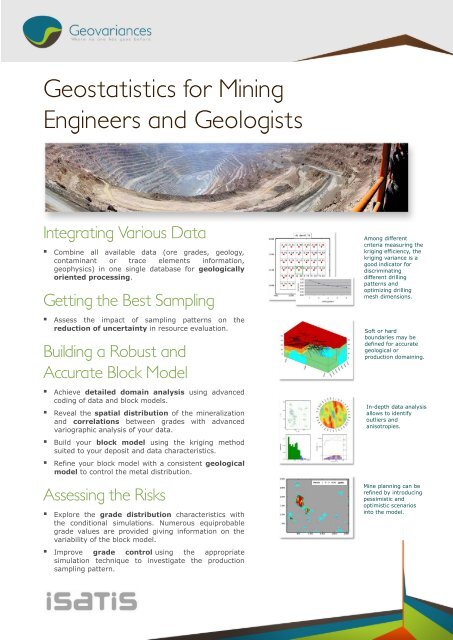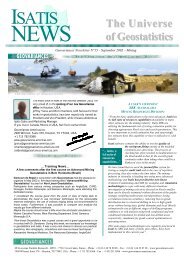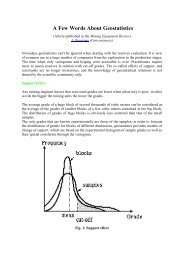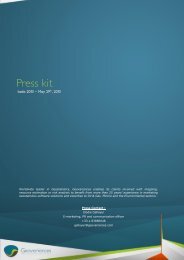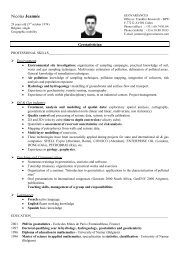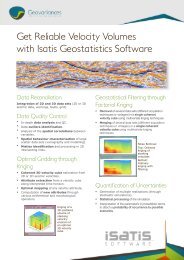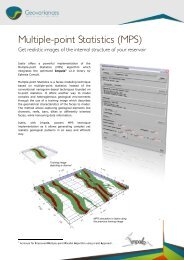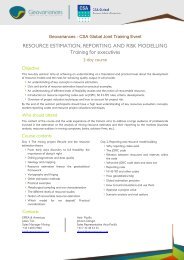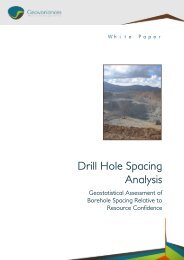Isatis, Geostatistics For Mining Engineers and ... - Geovariances
Isatis, Geostatistics For Mining Engineers and ... - Geovariances
Isatis, Geostatistics For Mining Engineers and ... - Geovariances
Create successful ePaper yourself
Turn your PDF publications into a flip-book with our unique Google optimized e-Paper software.
<strong>Geostatistics</strong> for <strong>Mining</strong><br />
<strong>Engineers</strong> <strong>and</strong> Geologists<br />
Integrating Various Data<br />
• Combine all available data (ore grades, geology,<br />
contaminant or trace elements information,<br />
geophysics) in one single database for geologically<br />
oriented processing.<br />
Getting the Best Sampling<br />
• Assess the impact of sampling patterns on the<br />
reduction of uncertainty in resource evaluation.<br />
Building a Robust <strong>and</strong><br />
Accurate Block Model<br />
• Achieve detailed domain analysis using advanced<br />
coding of data <strong>and</strong> block models.<br />
• Reveal the spatial distribution of the mineralization<br />
<strong>and</strong> correlations between grades with advanced<br />
variographic analysis of your data.<br />
• Build your block model using the kriging method<br />
suited to your deposit <strong>and</strong> data characteristics.<br />
• Refine your block model with a consistent geological<br />
model to control the metal distribution.<br />
Assessing the Risks<br />
• Explore the grade distribution characteristics with<br />
the conditional simulations. Numerous equiprobable<br />
grade values are provided giving information on the<br />
variability of the block model.<br />
• Improve grade control using the appropriate<br />
simulation technique to investigate the production<br />
sampling pattern.<br />
Among different<br />
criteria measuring the<br />
kriging efficiency, the<br />
kriging variance is a<br />
good indicator for<br />
discriminating<br />
different drilling<br />
patterns <strong>and</strong><br />
optimizing drilling<br />
mesh dimensions.<br />
Soft or hard<br />
boundaries may be<br />
defined for accurate<br />
geological or<br />
production domaining.<br />
In-depth data analysis<br />
allows to identify<br />
outliers <strong>and</strong><br />
anisotropies.<br />
Mine planning can be<br />
refined by introducing<br />
pessimistic <strong>and</strong><br />
optimistic scenarios<br />
into the model.
Adjusting the Selective <strong>Mining</strong><br />
Unit (SMU)<br />
• Evaluate the recoverable resources (ore, metal<br />
quantities) from the Grade-Tonnage curves according<br />
to SMU size <strong>and</strong> economic grade cut-off.<br />
ISATIS from<br />
Exploration to<br />
Production<br />
Various techniques are used to check the Block<br />
Support Effect: Uniform Conditioning (multivariate),<br />
Global Correction (through the anamorphosis<br />
function), conditional simulations.<br />
Evaluating the Information<br />
Effect<br />
• Anticipate the ore/waste decision at the feasibility<br />
stage to avoid misclassification at the production stage<br />
using non-linear techniques.<br />
Classifying the Resources<br />
• Obtain reliable classification of the resources into<br />
measured, indicated or inferred categories from<br />
Confidence Intervals computations.<br />
• Compare grades sampled at the plant facility with<br />
predicted grades for reconciliation.<br />
Estimated grades on blocks are compared to<br />
grade values at the plant facility, accounting<br />
for polygons, i.e. blasts.<br />
Automating the Geostatistical<br />
Process<br />
• Set up routine production workflow using batch<br />
facilities. Day-to-day production samples are easily<br />
integrated to quickly update grade estimates <strong>and</strong><br />
enhance mine planning.<br />
Exploration<br />
• Global resource estimation<br />
• Drilling pattern optimisation<br />
• Geostatistical insight on the geological<br />
representation<br />
• Uncertainty assessment<br />
Feasibility<br />
• Local recoverable resource estimation<br />
• Sensitivity of project profitability to SMU<br />
dimensions<br />
• Grade-Tonnage curves<br />
• Evaluation of the information effect on<br />
the ore recovery at the future<br />
production stage<br />
• Resource classification<br />
Production<br />
• Grade Control<br />
• Grade Reconciliation<br />
• Routine estimation update<br />
GEOVARIANCES offices<br />
France - Avon-Fontainebleau - +33 (0)1 6074 9090<br />
Australia - Wynnum-Brisbane, QLD - +61 (0)7 3348 5333<br />
info@geovariances.com - www.geovariances.com


